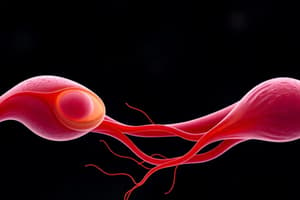Podcast
Questions and Answers
What is the core process involved in reproduction?
What is the core process involved in reproduction?
- Spermatogenesis
- Oogenesis
- Fertilization (correct)
- Meiosis II
Which process involves the production of millions of sperm in males?
Which process involves the production of millions of sperm in males?
- Spermatogenesis (correct)
- Meiosis II
- Oogenesis
- External fertilization
In which process do females develop eggs, known as oocytes?
In which process do females develop eggs, known as oocytes?
- External fertilization
- Spermatogenesis
- Meiosis II (correct)
- Fertilization
Where does fertilization occur in sea urchins?
Where does fertilization occur in sea urchins?
What type of fertilization involves the deposition of sperm inside the body cavity of the receiving partner?
What type of fertilization involves the deposition of sperm inside the body cavity of the receiving partner?
What contributes to the genetic distinctiveness of a new individual formed through fertilization?
What contributes to the genetic distinctiveness of a new individual formed through fertilization?
What is the function of flagellae in sperm during fertilization?
What is the function of flagellae in sperm during fertilization?
What is the role of the acrosomal reaction in sperm near an egg?
What is the role of the acrosomal reaction in sperm near an egg?
Which component of the egg becomes impenetrable to subsequent sperm after the first sperm entry?
Which component of the egg becomes impenetrable to subsequent sperm after the first sperm entry?
What is the purpose of species-specific surface proteins during fertilization?
What is the purpose of species-specific surface proteins during fertilization?
What mechanism do most multicellular organisms use to prevent polyspermy?
What mechanism do most multicellular organisms use to prevent polyspermy?
What is the outcome of syngamy during fertilization?
What is the outcome of syngamy during fertilization?
Study Notes
Reproduction: Exploring Fertilization
Reproduction is a fundamental process by which living organisms perpetuate their species. At its core lies fertilization — the union of two specialized cells called gametes from different individuals within a given species. This interaction between sperm and egg ultimately leads to the formation of a new, genetically distinct individual. Let's dive deeper into how this remarkable event occurs across various life forms.
Spermatogenesis & Oogenesis
Before discussing fertilization itself, it's essential to understand the processes through which male and female reproductive cells are produced: spermatogenesis and oogenesis. In males, spermatogenesis produces millions upon millions of sperm, each containing half the number of chromosomes needed for full genetic expression. Females develop eggs, known as oocytes, via meiosis II during oogenesis; however, only one mature oocyte reaches maturity in most species due to a lengthy period of growth and development before ovulation.
Sex Cells Meet: The Process of Fertilization
Fertilization occurs externally in some animals like sea urchins, whereas others experience internal fertilization, such as mammals. External fertilizers release large numbers of sperm simultaneously, targeting free-floating eggs. Internal fertilizers, on the other hand, deposit sperm inside the body cavity of the receiving partner for targeted encounters with eggs.
In both cases, successful fertilization depends on several factors:
- Motility: Sperm must swim towards the egg. Many sperm use flagellae (whip-like structures) to propel themselves forward.
- Swimming speed: A higher velocity increases the likelihood of reaching the egg. Some fish sperm can reach speeds over 6 meters per second!
- Acrosomal reaction: Once near an egg, sperm require an enzymatic blast toward the plasma membrane called the acrosomal reaction. This allows them to penetrate the protective covering surrounding the egg.
- Recognition: Species-specific surface proteins facilitate recognition and binding between sperm and egg. For example, human sperm recognize specific carbohydrates on the zona pellucida of the egg as part of their chemotactic response.
After penetrating the egg, the sperm nucleus fuses with the egg plasma membrane, eventually uniting with the egg cell nucleus in a process called syngamy.
Double Check – Polyspermy Prevention
To ensure proper inheritance, most multicellular organisms prevent polyspermy (the fusion of multiple spermatozoa with the single egg), typically using mechanisms triggered shortly after the first sperm entry. These include:
- Vitelline envelope: An additional layer around the egg that stiffens following sperm entry. Only one sperm can pass through.
- Cortical granules: Storage vesicles located beneath the plasma membrane of the egg. After the first sperm enters, these granules release cortexyl granule contents, causing the vitelline envelope to become impenetrable to subsequent sperm.
Once complete, fertilization ensures that each offspring receives precisely equal quantities of genetic material derived from their parents—half from mom, half from dad.
In summary, reproduction requires a complex series of events leading up to fertilization, including sperm production and motility, acrosome reactions, egg recognition, and polyspermy prevention. Each step relies on intricate molecular machinery that has evolved to produce unique and diverse progeny while maintaining the integrity of inherited traits across generations.
Studying That Suits You
Use AI to generate personalized quizzes and flashcards to suit your learning preferences.
Description
Test your knowledge on the process of fertilization and the essential steps leading to the creation of new genetically distinct individuals. Explore the concepts of spermatogenesis, oogenesis, motility, acrosomal reaction, recognition, and polyspermy prevention involved in the fascinating journey of reproduction.




